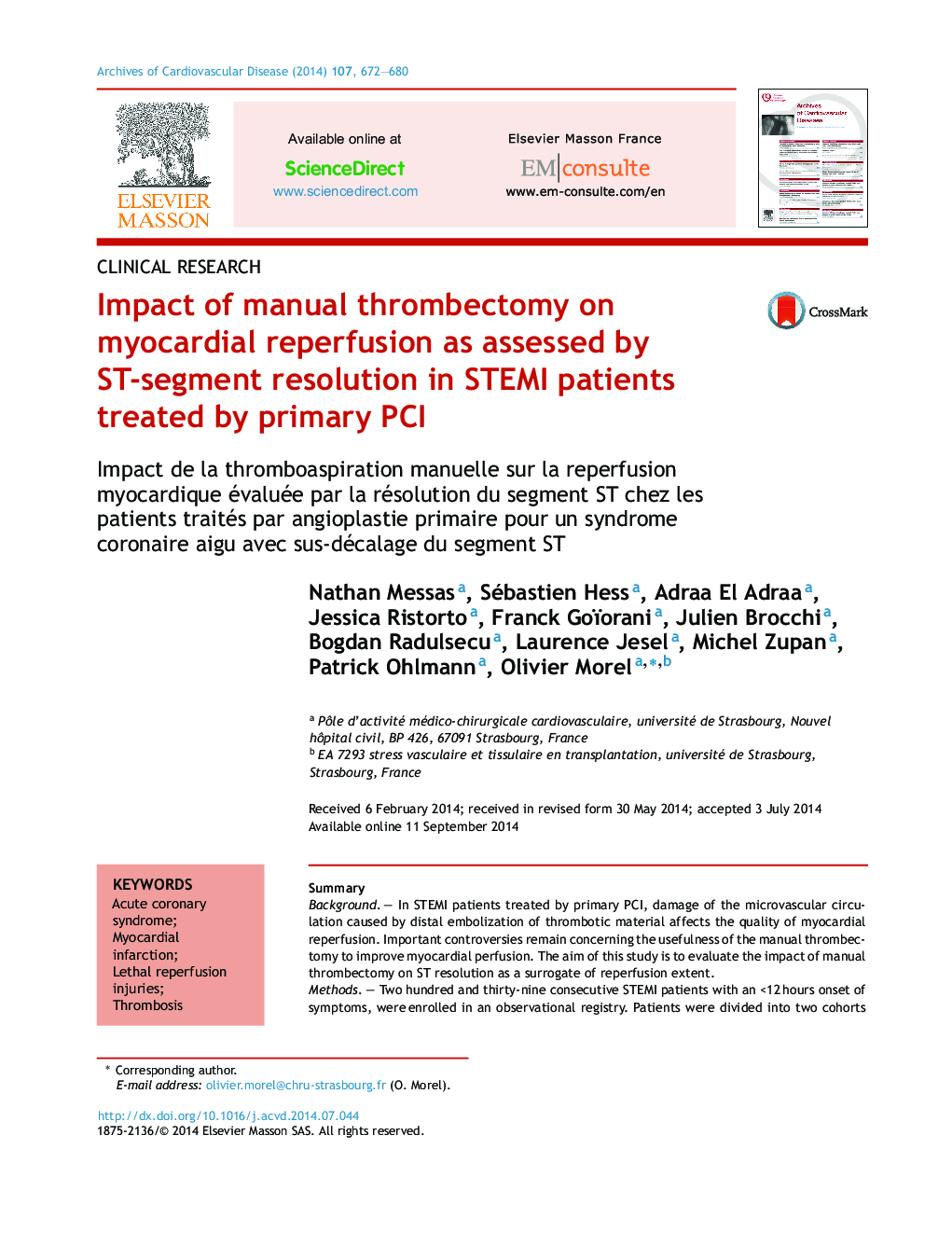| Article ID | Journal | Published Year | Pages | File Type |
|---|---|---|---|---|
| 2888857 | Archives of Cardiovascular Diseases | 2014 | 9 Pages |
SummaryBackgroundIn STEMI patients treated by primary PCI, damage of the microvascular circulation caused by distal embolization of thrombotic material affects the quality of myocardial reperfusion. Important controversies remain concerning the usefulness of the manual thrombectomy to improve myocardial perfusion. The aim of this study is to evaluate the impact of manual thrombectomy on ST resolution as a surrogate of reperfusion extent.MethodsTwo hundred and thirty-nine consecutive STEMI patients with an <12 hours onset of symptoms, were enrolled in an observational registry. Patients were divided into two cohorts according to the reperfusion strategy: manual thrombectomy before primary PCI (n = 102) or conventional-PCI (n = 137). The primary endpoint was the post procedural frequency of complete (>70%) resolution of ST segment elevation.ResultsA complete resolution of ST segment elevation occurred in 51.4% of patients in the thrombectomy group and in 35,6% of those in the conventional-PCI group (P = 0.018). Thrombectomy strategy was associated with a lower use of stents. Multivariate analysis identified manual thrombectomy (HR = 2.08 IC 95% (1.01–4.26); P = 0.046), inferior location and short ischemic delay (<180 min) as independent predictors of ST resolution. The cumulative Kaplan-Meier estimate of MACE was not significantly different between the two groups at one, three years follow-up.ConclusionIn STEMI patients, manual thrombectomy improves myocardial reperfusion as assessed by the percentage of ST segment resolution and a lower use of stents. However, in this cohort of limited size, this strategy did not translate into an improved cardiovascular outcome at one year follow-up.
RésuméIntroductionChez les patients traités par angioplastie primaire pour un syndrome coronaire aigu avec sus-décalage du segment ST, les dommages de la circulation microvasculaire, causés par l’embolisation distale de matériel thrombotique, affecte la qualité de la reperfusion myocardique. L’objectif de cette étude est d’évaluer l’impact de la thromboaspiration manuelle sur l’étendue de le reperfusion évaluée par la résolution du segment ST.MéthodesDeux cent trente-neuf patients consécutifs hospitalisés pour un syndrome coronaire aigu avec sus-décalage du segment ST ont été inclus dans un registre observationnel. Ces patients ont été subdivisés en 2 cohortes selon la stratégie de reperfusion usitée : thromboaspiration manuelle avant angioplastie primaire (n = 102) ou angioplastie conventionelle (n = 137). Le critère de jugement principal était le taux de résolution complète du segment ST (définie par une RST > 70 %) post procédural.RésultatsUne résolution complète du segment ST a été observée chez 51,4 % des patients du groupe Thromboaspiration et 35,6 % des patients du groupe angioplastie conventionelle (p = 0,018). La stratégie de thromboaspiration était associée à une moindre utilisation de stents. En analyse multivariée, la thromboaspiration manuelle, la localisation inférieure de l’infarctus et un délai court de reperfusion (< 180 min) sont apparus être des facteur prédictifs de résolution complète du segment ST. L’analyse de Kaplan Meier portant sur les évènements cardio-vasculaires adverses ne montrait pas de différences significatives entre les deux groupes pour un suivi de 1,3 ans.ConclusionChez les patients se présentant pour un syndrome coronaire aigu avec sus-décalage du segment ST, la thromboaspiration manuelle entraîne une amélioration de la reperfusion myocardique attestée par une fréquence accrue de résolution complète du segment ST et une moindre utilisation de stents. Cependant, dans cette cohorte de taille limitée, cette stratégie ne s’est pas accompagnée d’une amélioration du pronostic cardiovasculaire à 1 an.
